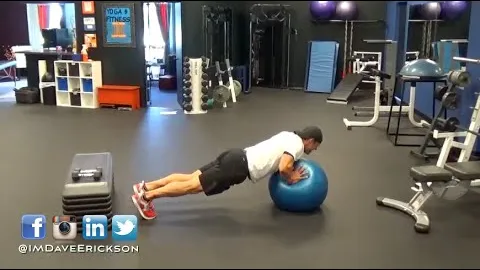Stability Ball Push-Up Exercise: Strengthen Your Upper Body and Core
The stability ball push-up exercise is a challenging and effective workout that targets the upper body muscles, including the chest, shoulders, and arms, while also engaging the core muscles for stability. Adding this exercise to your fitness routine can help improve strength, stability, and overall performance. In this article, we will discuss the proper technique, benefits, variations, and safety tips for performing the stability ball push-up exercise.
Technique:
- Starting Position: Begin by placing a stability ball on the floor and positioning yourself on top of it with your hands shoulder-width apart, directly under your shoulders. Walk your feet back until your body is in a straight line from head to heels, and your shins are resting on the stability ball.
- Engage Your Core: Before you start the push-up, engage your core muscles by pulling your belly button in towards your spine. This will create stability and support for your upper body during the exercise.
- Lowering Phase: Slowly lower your body towards the stability ball by bending your elbows, keeping them close to your sides. Your chest should be almost touching the stability ball, and your elbows should be at a 45-degree angle from your body.
- Pushing Phase: Push through your palms, extending your arms to a straight position, and lift your body back up to the starting position. Keep your core engaged throughout the movement.
Benefits:
- Upper Body Strength: The stability ball push-up primarily targets the chest, shoulders, and arms, helping to strengthen and tone these muscles. It is a highly effective exercise to build upper body strength.
- Core Stability: Performing push-ups on a stability ball requires core activation to maintain balance and stability. This helps engage and strengthen the muscles in your abdominals, obliques, and lower back.
- Improved Balance and Coordination: Due to the unstable nature of the stability ball, this exercise requires constant engagement of your muscles to maintain balance. Regularly practicing stability ball push-ups can enhance your overall balance and coordination.
- Full Body Workout: While primarily targeting the upper body and core, stability ball push-ups also engage other muscles such as the triceps, back, and even the legs, making it a complete full-body exercise.
- Enhanced Functional Strength: The stability ball push-up mimics the movements required in everyday activities, such as pushing or lifting objects. By performing this exercise, you can improve your functional strength for daily tasks.
- Increased Range of Motion: The stability ball allows for a deeper range of motion compared to traditional push-ups. This can lead to improved mobility and flexibility in the upper body muscles.
Variations:
- Easier Variation: If you find stability ball push-ups too challenging initially, you can modify the exercise by placing your hands on an elevated surface, such as a bench or step, instead of the stability ball. This reduces the instability and makes it easier to perform the movement.
- Harder Variation: To increase the difficulty of stability ball push-ups, you can try incorporating a single-leg lift. Perform the exercise as described above but raise one leg off the stability ball while maintaining a straight body position. This variation further engages the core and challenges your balance.
Safety Tips:
- Proper Form over Quantity: Focus on maintaining proper form and performing the exercise correctly rather than increasing the number of repetitions. This will ensure effective and safe results.
- Gradual Progression: If you are new to stability ball push-ups, start with a lower number of repetitions and gradually increase them as you build strength and stability. This will help prevent injuries and overexertion.
- Listen to Your Body: Pay attention to any discomfort or pain during the exercise. If you experience joint pain or any other discomfort, consult a healthcare professional before continuing with the exercise.
- Warm-up and Cool-down: Always warm up your muscles before performing stability ball push-ups. This can be done with light cardio exercises or dynamic stretches. Additionally, cool down with static stretches after completing the exercise to prevent muscle soreness.
Incorporating stability ball push-ups into your workout routine can yield numerous benefits for your upper body strength, core stability, and balance. Remember to start with proper technique, gradually progress, and prioritize safety. With regular practice, you will see improvement in your strength, stability, and overall fitness level.




